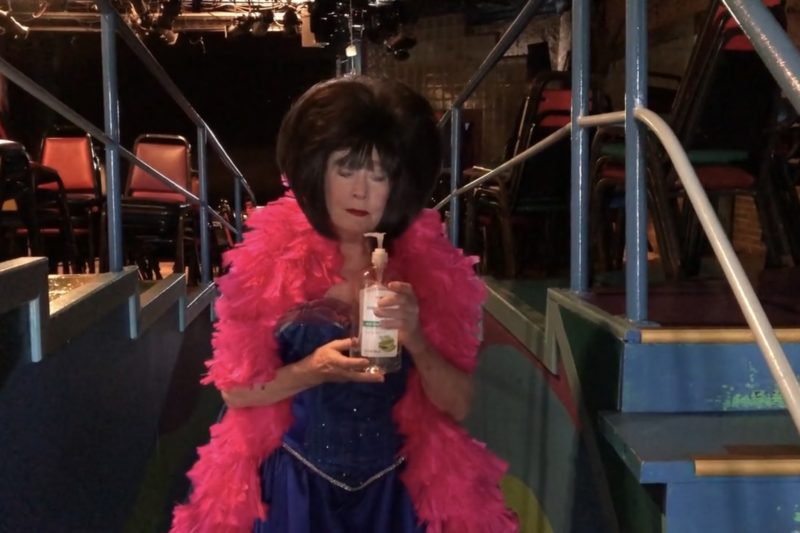For ‘Esther’s Follies,’ Show Goes On (Virtually)
By Sarah Kate Scribner
Reporting Texas

Austin comedy troupe Esther’s Follies’ cast performing ‘On Screen’ post pandemic (Courtesy Esther’s Follies)
On Friday and Saturday nights at Sixth and Red River in downtown Austin, nine actors and a magician would stand beneath the warm glow of stage lights and look out at the sea of 270 bodies crammed in the sold-out theater, eager to deliver the next gut-busting joke or burst into comedic song.
That was before March 2020 when theaters across Austin and America went dark.
“That’s what I miss the most, just hearing that guttural belly laugh from the audience,” actress Chelsee Jarnigan said. “It’s so rewarding because it’s just this small instant where I realize I did it, I did my job.”
Jarnigan is approaching her two-year anniversary as a cast member of Esther’s Follies, a modern-day vaudeville and political comedy theatre troupe in Austin that dubs itself the “Texas answer to SNL” on its website. Panning politicians and providing parodies during a pandemic has forced Esther’s Follies to improvise how the 43-year-old ensemble sketches its comedy.
Esther’s Follies is not alone. According to a study conducted by Americans for the Arts, approximately 96% of performing arts organizations (such as theater, music and art venues) nationwide have canceled in-person events and performances. About 73% of these organizations have responded to the aftermath of the coronavirus by increasing their online presence.
For Esther’s Follies specifically, video, audio overdubs and Zoom have taken the place of the stage. This digital content – pumped out two or three times a week and referred to as “Your Daily Dose of Esther’s” – is housed on Patreon, a membership platform that enables creators to run their own subscription-based content services.
“We didn’t get started on the Patreon subscription series until April, but since then, we’ve been doing very well and just growing,” Esther’s Follies owner Shannon Sedwick said. “Right now, there’s about 250 subscribers and they all pay anywhere from $5 a month to $100 a month, most within the $10 to $25 range, and all that money gets split up amongst the actors and the director and the writers.”
Staging a transition to Patreon was a mostly uncontested decision.
“There was talk made of doing some kind of live show and streaming it,” 21-year cast member and content writer Shaun Branigan said. “But the logistics of that to produce the sort of product that anybody would pay any amount of money to see are too staggeringly expensive to make it work.”
Though deciding to shift to a virtual platform was quick and seamless, cast members had to spend countless hours rethinking how to deliver comedy effectively online.
“It has been a real learning curve,” Sedwick said. “Our show had a certain punchline mentality — we did not want to ever have something that didn’t have a punchline or a laugh at the end of it. Usually it would be about every minute or so, or less – 30 seconds – that you’d need to have a laugh. And so when we didn’t have that, we just had to kind of figure out how to work with our new format of television and Zoom calls.”

Shannon Sedwick performs virtually after COVID-19 forced the comedy troupe’s theater to go dark (Courtesy Esther’s Follies)
The lack of laughter during their virtual comedy bits has not only altered the rhythm of the group’s sketches, medleys and musical numbers, but it also hampers their ability to determine what jokes are funny.
“You’re by yourself in your room with the computer and you’re just like, ‘I’m telling a joke now, is this funny? I hope it is,’” Jarnigan said while describing her experience performing online. “Nobody is there to be like, ‘Yes, that was it!’”
In addition to losing the feedback of laughter, Esther’s Follies can no longer expect phones to remain off for their virtual performances.
Jarnigan said the members of the troupe feel they are competing for their audience members’ attention with distractions on their devices – from pandemic updates to social media.
“It’s like, “Hey, ignore that email about the world being on fire and watch this funny video, you know?’” Jarnigan said. “[Moving online has] definitely been a transition in learning how to really captivate audiences through the internet.”
Going virtual has also impacted the actors’ personal performances.
“Oh my God, I’m so critical of myself,” 10-year cast member Billy Brooks said. “When I film something at home, I’ll re-watch it and go ‘Nope, not good enough.’ I even get a little vain sometimes and I’m like, ‘Ooh, I look terrible in this one.’”
In the midst of this season of adjustment and modification, not a single member of Esther’s Follies has left the troupe – not even when the changes involved yielded financial and personal challenges.
When asked how the revenue from Patreon subscribers compares to the revenue from typical live performance attendees, Sedwick laughed.
“Our theatre holds 270 and we would do two shows a night on Friday and Saturday,” Sedwick said. “We would sell out all four shows and every ticket was around $25 to $35 so not at all coming anywhere close.
”In addition to the monthly Patreon earnings, which generate about $2,500 a month, Sedwick set up a “Performer’s Fund” that runs on audience donations in an attempt to ease the financial burden on her cast and staff. But even with this added support, Sedwick said the cast members are only making around $150 to $400 a month.
At this stage, all of the actors have filed for unemployment.
As Branigan puts it: “God bless them, people are giving very generously – but it’s certainly nothing to live on.”
The actors have had to get creative these past few months with what jobs to take on in order to supplement their work at Esther’s Follies.
“I have been doing more film jobs and I’ve done a [State Farm] commercial under COVID guidelines since all of this has happened,” Jarnigan said. “I’m just sending in auditions and trying to get on projects anywhere that I can.”
Jarnigan aims to audition at least once a week. She’s been finding these opportunities from friends in the film industry, Austin actor pages on Facebook and her recently-acquired agent as of last month – the TAG Talent Agency.
Friends in the entertainment field have also been a valuable resource for 14-year Esther’s Follies cast member – and Branigan’s housemate – Ted Meredith, who has been auditioning two or three times a week.
“I found out about [voiceover opportunities] from a friend of mine from college, and somebody that I made a web series with eight years ago,” Meredith said. “I’m glad I paid attention back in those web series days.”
Brooks, on the other hand, has sent in auditions every two or three weeks while concentrating on his live podcast “The Weekly Roast and Toast.” This has doubled as a creative outlet and a source of income.
Branigan is not actively looking for work, but in addition to writing content for Esther’s Follies – and thus getting a slightly larger slice of the revenue – he is co-running an internet comedy content provider with Meredith.
Though the actors are grateful for the work as they get it, they said each opportunity will not do anything more than help them stay afloat.
“It’s nothing that’s going to take me off unemployment anytime soon,” Meredith said. “It’s all piecemeals.”
The actors aren’t just grappling with financial strain – they’re hurdling mental obstacles, too.
“I feel like a lot of performers put their self-worth into what they do, and so when I had nothing to do, I was like, ‘I’m worthless. I’ll never do anything again,’” Jarnigan said. “And it was tough, but there’s light at the end of the tunnel. You got to look on the positive side – and drink a lot, which is what I did.”
The actors have also dealt with the mental exhaustion of isolation and the disappointment of being unable to see each other in person for months. Their weekly writer’s meetings on Mondays take place over Zoom and very rarely do they film (socially distanced) videos at the Esther’s Follies venue or outside of their homes.
Jarnigan has only been to the theater three times since the pandemic began.
“We went from seeing each other every single day of the week to nothing,” Jarnigan said. “It felt like somebody ripped my arm off and threw it across the lawn.”
These are unprecedented times that have caused intense bouts of stress and worrying, negatively affecting the mental health of people all around the world.
“We’re going to need things like Esther’s Follies to bring some lightness to everything,” 69-year-old retired theatre director and long-time Esther’s Follies fan Michael Harlan said.
Harlan, who came to Austin to study theatre at UT in 1973, has been a loyal follower of Esther’s Follies ever since its inception in the spring of 1977.
“When I was a college student, I went quite a bit because my evenings were free for the most part, at least on weekends,” Harlan said. “I didn’t go quite as much when I was teaching [at Westlake] full time, because we were just so busy…but now that I’ve been retired for about eight years, I’ve been going more and I cannot wait until we can go again.”
Harlan said he was one of the first subscribers to “Your Daily Dose of Esther’s” when the platform was released and is the proud recipient of a free Esther’s Follies T-shirt that came with his subscription.
Though their number of subscribers does not match the number of in-person performance attendees, Esther’s Follies still retains its status as an Austin staple with a core fan base, which eagerly anticipates the return of the comedy troupe to the stage.
“We hope that maybe by the end of the year, or the first part of next year, we’ll be able to start doing shows again for less people, for 100 or something like that,” Sedwick said. “That’s our goal.”
Sedwick says that a soft reopening is completely dependent on her ability to guarantee the safety of the audience members, as well as the actors. She says it may take getting a vaccine before she’s willing to fly up the curtain.
“We shall wait and see,” Jarnigan said. “And until then we are still going to try to make you laugh.”